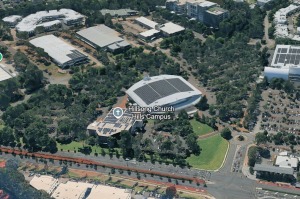The haunting of Bishop Pike

On February 4, 1966, 20-year-old James Pike Jr., son of controversial Episcopal Bishop James Pike, committed suicide in a New York City hotel room.
Shortly afterward, the Bishop began experiencing poltergeist-styled activity in the Cambridge flat where he and his son had lived. The unexplained activities were witnessed by Reverend David Barr and Maren Bergrud of the Episcopal Diocese of California who occupied the flat with the Bishop.
Pike, who had previously disbelieved in life after death, became convinced that his deceased son was trying to communicate with him from the afterlife. The various phenomena that occurred in the residence had the ‘signature’ of his dead son and relayed information in a way that only the younger Pike would know.
Distraught over the death of his son, and moved by the remarkable activities he was seeing with his own eyes, the Bishop began visiting a number of mediums in an attempt to communicate with James Jr. While fraud and failure are the norms in the psychic domain, the Bishop sought out well-known mediums who brought, during their sessions, the evidence he was seeking.
One of the end results of the Bishop’s pursuits was The Other Side, a book authored by Pike that chronicled his paranormal experiences and newfound faith in the hereafter. The work was well received during the era in which the Bishop lived, a time many say was the dawn of the occult age and the supposed Age of Aquarius.
The question, of course, is: what really happened with the Bishop? Did he have actual experiences with his dead son, or was he in contact with something else?
The devil’s agenda
The story of Pike is told from a Christian perspective in the book, The Haunting of Bishop Pike, written by Dr. Merrill Unger, an expert in demonology, who for years taught at Dallas Theological Seminary. Unger notes that, because of the credible evidence gathered in this case, the Bishop’s experiences were not the self-deceived or been-tricked kind so common in the spiritist realm, but instead was the real thing.
The activities and communication that occurred in the Bishop’s flat and the information relayed to him through the mediums he visited could not be disputed. The personalities behind that contact, though, insists Unger, were not those of the Bishop’s son and other relatives, but instead were what the Bible calls angels of light (2 Cor. 11:14).
And what was their agenda?
Unger observes, “The essential thing to understand concerning all the phenomena of spiritualism, whether telekinesis, psychic visions, automatic writing, trance speaking, materializations, apparitions, excursions of the psyche, or whatever is that fact is used as a springboard to fraud…Satan’s masquerading as an angel of light is far more destructive than his forays as a devouring lion” (emphasis in the original).
In other words, the devil’s agenda often includes the use of a little truth to capture the undiscerning and lead them eventually down the wrong path. An example of this is seen in the book of Acts: “It happened that as we [Paul and the author of Acts] were going to the place of prayer, a slave-girl having a spirit of divination met us, who was bringing her masters much profit by fortune-telling. Following after Paul and us, she kept crying out, saying, “These men are bond-servants of the Most High God, who are proclaiming to you the way of salvation” (Acts 16:16-17).
This account shows that Satan will even go so far as to green-light the gospel’s proclamation if it allows his association with God’s people to distort and pollute the truth ultimately. The devil knows humanity instinctively craves the immaterial, which is something G.K. Chesterton notes in his book The Everlasting Man: “Nature is always looking for the supernatural.”
Of course, the enemy doesn’t care which error-ridden trail (e.g., atheism or occultism) a person takes as long as it doesn’t lead him to Jesus. As C.S. Lewis says, the enemy “hails a materialist or a magician with the same delight.”
Pike, being someone who was regarded as heretical by his own denomination, lacked the discernment to understand that the supernatural he was encountering was not the holy kind. Unger says: “Bishop Pike was unable to evaluate his psychic experiences properly and to react wisely because he had rejected the Word of God as authoritative and final.”
And what was the Bishop's final outcome? He was found dead in a desert by the Dead Sea on September 7, 1969, having succumbed to the elements. Why he met the end that he did is something no one can fully explain.
Unger sums up the tragic end of the Bishop with a warning that applies to all of us: “The healings by spiritualistic mediums through demonic power are not free and purely beneficent. They always operate under the principle of compensation, with a price tag attached to them… [And that] price must be paid throughout eternity.”
Robin Schumacher is an accomplished software executive and Christian apologist who has written many articles, authored and contributed to several Christian books, appeared on nationally syndicated radio programs, and presented at apologetic events. He holds a BS in Business, Master's in Christian apologetics and a Ph.D. in New Testament. His latest book is, A Confident Faith: Winning people to Christ with the apologetics of the Apostle Paul.



























